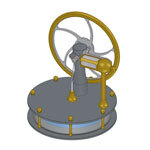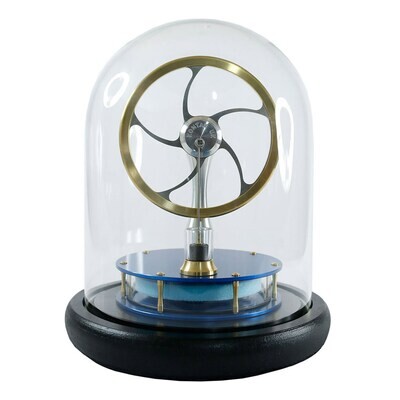KS90V Aluminium Stirling Engine
90° V configuration
The KS90V Low Temperature Stirling Engine configuration lifts the power piston and cylinder up from the top plate and places it horizontally level with the main axle and crank, with the power cylinder being connected to the main chamber by a small stainless steel tube. This allows both connecting rods to attach directly to the same crank mechanism and gives a shorter, more compact engine. The engine also features anodised aluminium chamber plates, super-lightweight flywheel spokes and a solid brass rim, all styled in an elegant and efficient manner.
Eco-friendly
This KS90V engine is the ultimate eco-friendly device, showing with one spin of the flywheel a clean and simple way of converting waste heat into motion. Because these engines rely on a temperature difference for operation, they will run on almost any heat source. Typical heat sources include hot coffee or tea, warm sunlight, TV digibox and the human hand. As long as one plate is 5°c to 10°c warmer than the other the engine will run. It doesn't matter which plate is warm, as long as the other is cooler. If you warm the bottom plate the engine will run clockwise, if you reverse the temperature differential and warm the top plate the engine will run anti-clockwise.
How does it work?
Stirling engines work by cyclically heating and cooling the air inside the main chamber. As the air heats up it expands, and as it cools down it contracts. This expansion and contraction drives a small piston which in turn drives the flywheel. The clever thing about Stirling engines is that the mechanism for cycling the heating and cooling of the air is built into the engine in the form of the displacer, which is driven by the flywheel and crank arrangement and moves the air from the warm side to the cool side and back again over and over.
The Stirling engine is named after its inventor, Rev. Robert Stirling, who patented his idea in 1816.
Heat Sources
- The engine can run on strong direct sunlight. The top surface will be the hot side and the bottom the cool side and the engine will run anti-clockwise.
- The engine can run on hand heat. If you have a warm hand in a cool room the engine will run from the heat of your hand.
- Placing the engine on top of a freshly made cup tea or coffee (NOT BOILING) will provide enough energy for it to run at a relatively high speed for up to 30 minutes.
- Placing the engine over a bowl of ice will provide enough temperature difference for operation. Similar to solar operation the top surface will be the hot side and the bottom the cool side, and the engine will run anti-clockwise. You can also place a dish of ice on the top plate for clockwise operation.
Main features:
- 90° power piston and displacer discconfiguration
- Will run on a 5°c to 10°c temperature difference
- Extremely low friction self-lubricating graphite piston
- Built in flywheel balancing
- Main chamber pillars thermally isolated with nylon screws
- Regenerating displacer disc
Materials
- Stainless steel connecting rods and ball-race bearings
- PEEK connecting rod bushes
- Micron precision borosilicate glass cylinder
- Micron precision graphite power piston
- Aluminium main pillar, hub and spokes
- Brass chamber pillars and flywheel rim
- Brass gland and cylinder holder
- Aluminium plates
Dimensions
- Plates - 92mm diameter, 3mm thick (3.62" x 0.19")
- Displacer - 70mm diameter, 7mm thick (2.75" x 0.27")
- Flywheel - 82.5mm diameter, 4mm thick (3.25" x 0.16")
- Power piston - 9.5mm diameter (0.375")
- Overall height - 130mm (5.11")
Assembled or Kit
The engine is available fully assembled and ready to go or as a self-assembly kit.
Instructions
Click the image below for PDF assembly, operation and maintenance instructions.
 |
| KS90V |




